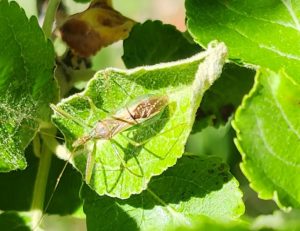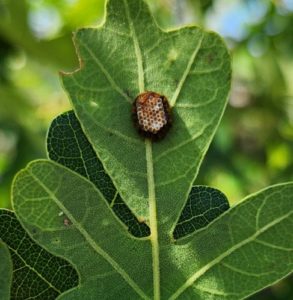
Leafhopper Assassin Bug (Zelus renardii) photo: Christie Collins
The Leafhopper Assassin Bug (Zelus renardii): An Unsung Hero of New Mexico Gardens
New Mexico’s diverse ecosystems are home to a fascinating array of wildlife, and among the most intriguing are the often-overlooked assassin bugs. One particularly notable species is the Leafhopper Assassin Bug (Zelus renardii). This small yet formidable predator plays a necessary role in maintaining the ecological balance within our gardens and natural landscapes.
Identifying the Leafhopper Assassin Bug
The Leafhopper Assassin Bug is a member of the Reduviidae family, characterized by its elongated body, long legs, and a distinctively curved proboscis. Adult Zelus renardii typically measure around 10-15 millimeters in length (.5 inches) and are easily recognizable by their green or brownish coloration with subtle white markings. Their slender bodies and swift movements make them adept hunters, capable of ambushing a variety of prey.
Habitat and Distribution
In New Mexico, the leafhopper assassin bug can be found in a variety of habitats, ranging from gardens and agricultural fields to more wild and natural areas. These assassin bugs are particularly drawn to areas with abundant vegetation, where they can find abundant cover and hunting opportunities. Their presence in gardens is especially beneficial, as they help control populations of pest insects that can damage plants.
Hunting Techniques and Diet

Assassin bug egg case Photo: Joanna Ruppel
The hunting strategy of the Leafhopper Assassin Bug is both fascinating and efficient. These bugs are ambush predators, relying on their stealth and patience to capture unsuspecting prey. They typically lie in wait on leaves or stems, using their excellent camouflage to blend into their surroundings. When a suitable target, such as a leafhopper, caterpillar, or aphid, comes within striking distance, the assassin bug swiftly impales it with its sharp proboscis. The proboscis of the assassin bug is a multifunctional tool. Not only does it serve as a weapon for capturing prey, but it also injects a digestive enzyme that liquefies the insides of the victim. This process allows the assassin bug to efficiently consume its prey, sucking up the nutrient-rich fluids. This predation helps keep pest populations in check, providing a natural form of pest control that benefits gardeners.
Ecological Importance
As a natural predator, this assassin bug helps regulate insect populations, preventing outbreaks of pests that can harm crops and native plants. By preying on species such as leafhoppers, aphids, and caterpillars, Zelus renardii contributes to the overall health and balance of the environment. Additionally, the presence of these assassin bugs indicates a healthy and diverse ecosystem. They are part of a complex web of interactions that include predators, prey, and plants, all of which are essential for ecological stability. Encouraging the presence of assassin bugs in gardens and natural areas is a good step towards promoting biodiversity and sustainable pest management practices.
Encouraging Assassin Bugs in Your Garden
Gardeners in New Mexico can take several steps to attract and support Leafhopper Assassin Bugs. Planting a variety of native plants can provide the necessary habitat and food sources for these beneficial insects. Additionally, minimizing the use of chemical pesticides will help ensure that assassin bugs and other natural predators can thrive. Creating a garden environment that supports a diverse range of species not only benefits the Leafhopper Assassin Bug but also enhances the overall health and resilience of the garden ecosystem.
The Leafhopper Assassin Bug is a significant insect that plays a vital role in maintaining the ecological balance within New Mexico’s gardens and natural landscapes. Their predatory habits help control pest populations, making them invaluable allies for gardeners. By understanding and supporting these fascinating creatures, we can promote a healthier, more sustainable environment.


